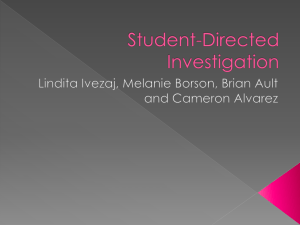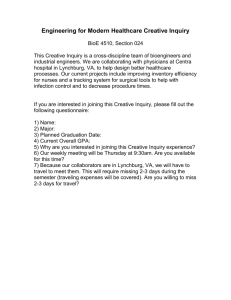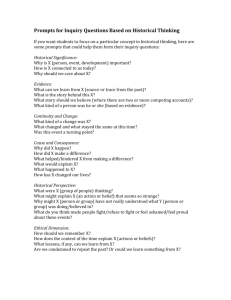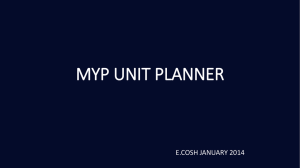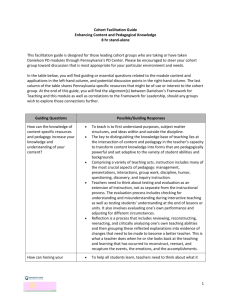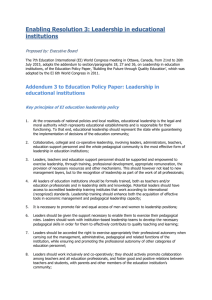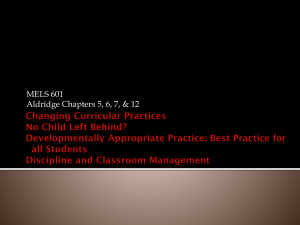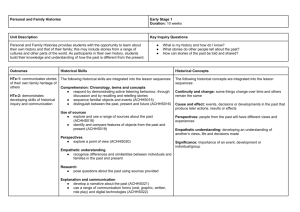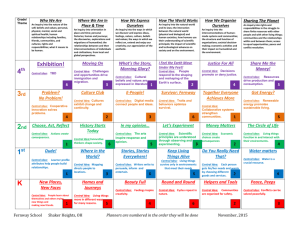Different forms of representation for design
advertisement
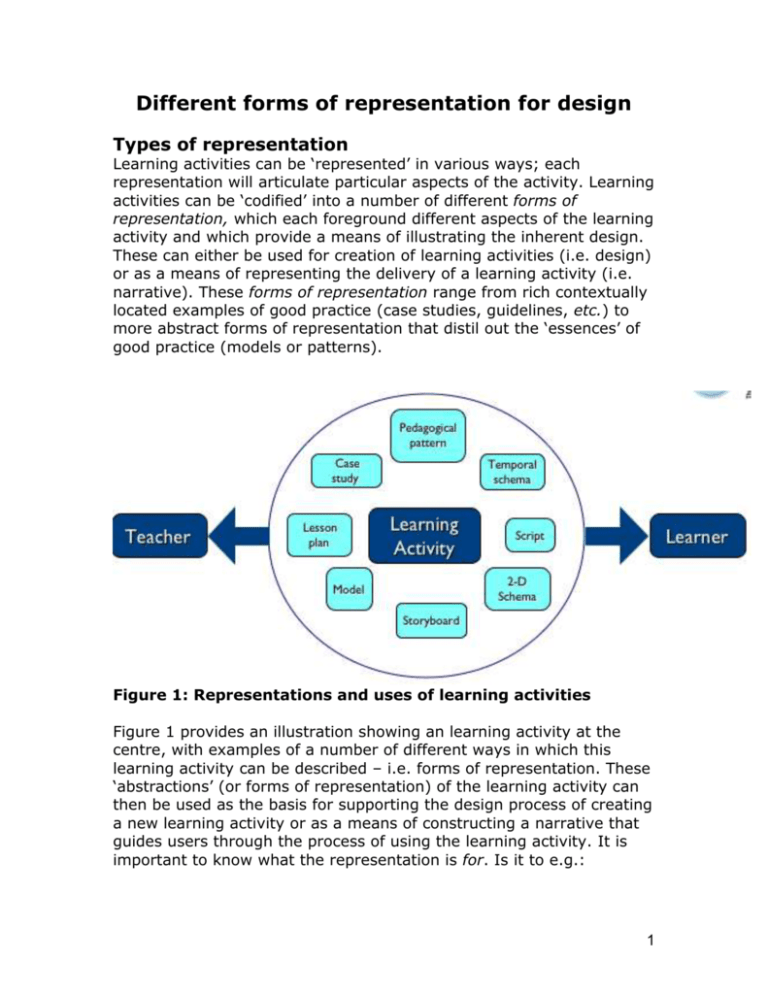
Different forms of representation for design Types of representation Learning activities can be ‘represented’ in various ways; each representation will articulate particular aspects of the activity. Learning activities can be ‘codified’ into a number of different forms of representation, which each foreground different aspects of the learning activity and which provide a means of illustrating the inherent design. These can either be used for creation of learning activities (i.e. design) or as a means of representing the delivery of a learning activity (i.e. narrative). These forms of representation range from rich contextually located examples of good practice (case studies, guidelines, etc.) to more abstract forms of representation that distil out the ‘essences’ of good practice (models or patterns). Figure 1: Representations and uses of learning activities Figure 1 provides an illustration showing an learning activity at the centre, with examples of a number of different ways in which this learning activity can be described – i.e. forms of representation. These ‘abstractions’ (or forms of representation) of the learning activity can then be used as the basis for supporting the design process of creating a new learning activity or as a means of constructing a narrative that guides users through the process of using the learning activity. It is important to know what the representation is for. Is it to e.g.: 1 enable educational researchers to analyse and develop educational innovations; enable teachers to plan lessons; enable software designers to instantiate lesson designs in software; help learners to understand their teaching and learning. The type of representation would appear to be crucially dependent on it purpose. Layers of representation Although it is evident that any number of forms of representation might be possible this section differentiates between three different levels of representations that are particularly important and provides suggestions for examples of ‘forms of representation’ that might be used within each of these levels: an educational component (the pedagogical intention and aspiration), a technological component (what technologies will be used, how and their associated affordances) and a process-based/operational component, which describes the process or operational dimension provides the link between these. Therefore we suggest it is useful to think in terms of the following three levels (see also figure 2): 1. Educational view: The underlying pedagogical/inquiry model (may want to sub-represent this in a number of ways) a. Objectives/outcomes/competences b. Pedagogical model c. Assessment d. Constraints 2. Process-based/Operational view: Both the educational and technical (see below) perspectives require a representation of process. Technically we might need to represent process: On different levels of granularity o curriculum style lesson plans o minute by minute orchestration of group collaboration On different levels of formality: o Give appropriate prompts to learners while measuring temperature o IF t < 0 OR t > 40 THEN….ELSE Existing languages available to specify a learning process have different emphases: a. Stage-based: The key stages involved in the learning activity – i.e. a descriptive overview or account of the key stages or 2 aspects involved. Control-flow style representations such as LAMS. The focus is on modules and their sequencing. b. Schema: Outlining the sequential set of tasks and associated roles, resources, tools and outputs. Schematic representations of role, outcome, activity, environment such as IMS LD. More finegrained than stage-based representations but dynamics can be hard to express. c. Rule-based: Blackboard style representation such as TSpace. Good for coordination/prompting but can lose the high-level view. 3. Technical view a. The technical implementation blueprint b. Rule-based and runtime of the data flow In addition it may be necessary to provide some form of crossrepresentation mapping – i.e. dialogue between the three in terms of needs and constraints. Figure 2: Three layers of representation of learning activities Case study As a means of illustrating the above the text that follows provides a walk through of a learning activity that has been used in the ESRC/EPSRC TEL project – Personalised Inquiry (PI) (http://www.piproject.ac.uk/). It is important to note however, that this example is 3 general in nature and does not provide the level of detail or context that a real example would, hence the descriptions in this section reflect this general level rather than providing details to specific resources or tools for example. Educational view The educational view can take a number of forms of representation. This might consist of a pedagogical model describing the inquiry-based approach being adopted, it might give an outline of the overarching key educational goals or provide some form of narrative (such as a case study or pedagogical pattern). The example illustrated here shows the case study in two formats: a) a description of the educational approach, b) a pedagogical pattern. Description of educational approach The students are set an inquiry-based problem. They choose different methods of inquiry to address tackle the problem and work individually and then collectively to solve the problem. The learning outcomes are: 1. The students will be able to apply a set of Scientific principles within a range of contexts 2. The students will gain experience of using a range of tools of inquiry to address Scientific problems 3. The students will gain experience and competence in the use of mobile devices across different context 4. The student will develop an understanding of the use of collective resources in addressing specific inquiries. Pedagogical pattern Pedagogical pattern: Collaborative inquiry across different context using different technologies Context: A learning activity primarily designed to be used in a secondary school context to help the children to develop inquiry-based approaches to Scientific investigations Problem: Student have difficulties in relating abstract concepts and formal representations to real life examples Students need to rigorously examine and test their understanding of evidence derived from observations. Solution: Use a real life, authentic problem to drive the scenario Provide a number of different ways in which the students can 4 investigate the problem Provide students with experience of working individually and building collectively on the work of others Situate Scientific investigation in a real life context Provide flexible and contextual scaffolding to guide the students Provide multiple resources and tools to support flexible investigation by the students Example: Teacher poses a open end questions and students choose different inquiry methods to address it, results are pooled and discussed Related pedagogical approaches: Problem-based learning, collaborative inquiry, scientific investigation, resource-based learning, collaborative learning Process view Three examples of process views are given: a simple steps/stages example, a lesson plan and a schema. Stages 1. The teacher poses an open question, of interest to students, to prompt debate. 2. Students use their handheld devices linked to a classroom data projector to generate initial responses, which are automatically clustered and displayed along different dimensions. 3. The software selects teams of students whose answers differ along the dimensions and sets them the challenge to move closer in agreement through inquiry and debate. 4. Each team chooses one or more methods of inquiry, such as ‘debate with expert’ or ‘run experiments outdoors’. 5. Software running on their mobile devices provides tools and curriculum materials to structure their investigations as they move between locations, and to transmit the results to a team website; 6. The system guides the students at home and in school to share data, analyse the evidence, and try to reach consensus; 7. Their results, and changes in response to the initial question, are presented and compared in the classroom through a discussion mediated by the teacher. 5 Lesson plan Lesson plan template Class: Year 7 Date: Produced by: Learning outcomes 1. The students will be able to apply a set of Scientific principles within a range of contexts 2. The students will gain experience of using a range of tools of inquiry to address Scientific problems 3. The students will gain experience and competence in the use of mobile devices across different context 4. The student will develop an understanding of the use of collective resources in addressing specific inquiries. Lesson outline Structure Groupings Activities 1. Teacher poses 1. Class-based 1.Class debate. Clarification question re: nature of the activity 2. Generation and 2. Individual, 2. Individual responses, clustering of ideas then class-based clustering, discussion 3. Team selection 3. Team-based 3. Initial discussion re: challenge 4. Choice of method 4. Team-based 4. Consideration of the factors of inquiry associated with the methods 5. Use of tools and resources, 5. Investigation 5. Team-based gathering of data 6. Sharing of data, discussion 6. Data sharing and and attempt to reach analysis 6. Team-based consensus 7. Presentation of group results, comparison and 7. Pooling of results 7. Class-based discussion Resources and tools Whiteboard, data projector, mobile devices, teacher directed resources, student source resources, Differentiation Methods offer different degrees of sophistication, individuals can contribute in different ways and to different degrees in the teams Examples of follow 1. Adoption of a similar approach in a different on activities context 2. Swamping and comparison of methods across teams 3. Carrying out a longitudinal investigation of a similar nature 4. Aggregating findings with other sources – another school, or via a distributed data collection centre 6 Schema A partial representation of the Schema is illustrated in Figure 3. This has been mapped using an Learning Design adapted version of Compendium. A interactive version of this is available online (http://openlearn.open.ac.uk/file.php/2824/kmap/1195028702/pi_wp 2_scenario.html). Note that notes can contain a number of levels of additional detail, as well as links to other file types – web sites, diagrams, programes, resources etc. Figure 3 7 Therefore the overall steps [1..7] of the learning activity can most easily be expressed in a stage-based way. Many of the details of the steps (e.g. question leads to student responses on data projector) seem to be most easily expressed in a schema-based way. Some details (e.g. guiding and prompting to share data and analyse) might most easily be expressed in a rule-based way. Technical view The technical view includes: Device functionality and recommendations: The schema representation above refers to various hardware devices that will be required to run an activity, such as a mobile device and data projector. It can be expected that the detail will not require a specific make or model of device but rather one of a class of suitable devices. From a technical viewpoint there may be a number of constraints (e.g. requires bluetooth, wifi, etc.). Also from an educational viewpoint there may be a number of requirements or recommendations (e.g. touchscreen as preferred method of interaction). Software functionality and recommendations: Similarly, it can be expected that it may be possible to use different software tools. These will often be web-based tools that are receiving data from or sending data to other parts of the programme. For example, a visualisation software tool may take as input data readings from an early part of the programme. For this to work, the technical layer will have to specify appropriate data formats for interoperability. Further requirements may come from an educational viewpoint, such as which visualisation tools are most suitable to support a classroom discussion of the findings. Specification of data structures and the creation, flow and transformation of data during the running of an activity: At a technical level the inquiry process for the individual, group and class will have to be specified in terms of the required data structures (for storing e.g. sensor measurements, audio files, group allocation, notes, etc.) and dependencies between them (e.g. storing a graph generated using the data collected previously). To facilitate reuse and adaptation it will be important that these data structures can accommodate different types of activities rather than being hard-wired for specific examples. For example, the teacher or student may decide that CO2 should be measured instead of, of as well as temperature. This should be specified directly at a teacher or learner interface level. Coordination and management of the process: On a technical level, there is a need to specify and run support for the 8 management and coordination of the activity for the individual, group and class. This will be more than a pre-determined flowchart for the activity and will require representation and use of conditionals within the programme for e.g. orchestrating collaborations and providing learner prompts. Metadata description for classification and search and retrieval: The programme can be expected to have associated metadata for classification and search in e.g. RDF. This metadata will draw on the formal specifications used for the data structures and coordination plus the higher process and educational views. Conclusion It is important to note that research in this area is still highly contested. There is as yet no clear understanding/agreement of how best to a) represent learning activities, b) support and represent the design process, or c) provide navigation support or scaffolding narratives. A number of key questions and issues around the concepts of design and narrative remain: What are the most appropriate forms of representation to use? How will we address the know issues which have arisen in other research on learning objects, learning design and narrative, eg: a) issues of granularity, b) context vs. abstraction, c) purpose (different views for different audiences – teacher, educational researcher, student, School IT support), d) context (teacher deciding whether to use a learning design, developer/teacher modifying or authoring a design, teacher monitoring the running of a design, student understanding the objective of the design), e) uptake (justification for investment in time in understanding or creating design and narratives) and f) sustainability (repurposing and reuse of designs and narratives, the creation of a user-generated community of designs and narratives). Acknowledgements This briefing paper is an adaptation of a Working Paper that was produced by Gráinne Conole and Paul Mulholland as part of the PI project, which is funded by the EPSRC/ESRC research councils. PI is a large, interdisciplinary project, the principal investigators are Mike Sharples and Eileen Scanlon. Further details about the PI project can be found on the project website http://www.pi-project.ac.uk/. Other key members of the research team are Shaaron Ainsworth, Steve Benford, Trevor Collins, Charles Crook, Mark Gaved, Chris Greenhalgh, Ann Jones, Karen Littleton, Claire O’Malley, Hazel Martin, Alison Twiner, and Michael White 9
